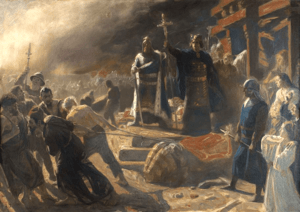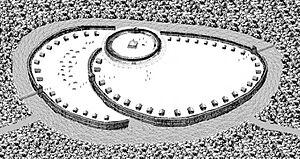Polabian Slavs facts for kids

The Polabian Slavs, also called Elbe Slavs or more widely known as Wends, were a group of West Slavic tribes. They lived along the Elbe river in what is now eastern Germany. Their territory stretched from the Baltic Sea in the north to the Ore Mountains in the south.
These tribes were mostly conquered by the Saxons and Danes starting in the 800s. Over time, they became part of the Holy Roman Empire. The Polabian Slavs slowly adopted German culture and language. Today, only the Sorbs have kept their unique identity and culture.
The original Polabian language is no longer spoken. However, two Sorbian languages are still spoken by about 22,000–30,000 people. The German government recognizes these languages as official in the region.
Contents
Who Were the Polabian Slavic Tribes?
An old document from 830, called the Bavarian Geographer, lists many tribes living east of the Elbe river. It mentions the Uuilci (Veleti) with 95 towns, the Nortabtrezi (Obotrites) with 53 towns, and the Surbi (Sorbs) with 50 towns.
Historians often group the Polabian Slavs into three main tribes:
- The Obotrites
- The Veleti (also known as Liutizians)
- The Lusatian Sorbs
The Obotrite group included tribes like the Wagrians and the Polabians themselves. The Veleti group had tribes like the Kessinians and the Rani from Rügen. The Sorbian group included tribes like the Milceni and the Lusici.
A Look at Polabian Slavic History
The Polabian Slavs moved into this area around the 500s. They settled in lands left empty by Germanic tribes who had moved away. Early Slavic pottery has been found from the late 500s. However, most of their settlements and items date from the 700s onwards.
By the 700s, the Slavic settlements were quite stable. Charlemagne, a powerful Frankish ruler, even teamed up with the Obotrites to fight against the Saxons. The Franks also created the Sorbian March to protect their lands from the Sorbs.
German Campaigns and Rebellions
German attacks on the Slavs became serious during the time of the Ottonian dynasty. King Henry the Fowler and his son Otto I led many campaigns. They set up special border areas called "marches" to guard their new eastern lands. They also founded churches to help convert the Slavs to Christianity.
But in 982, after a big defeat for the Germans, the pagan Slavs rebelled. The Hevelli and Liutizi tribes destroyed churches, and the Obotrites attacked Hamburg. Some Slavs even crossed the Elbe river. However, the Christian Duke of Poland, Mieszko I, attacked them from the east, forcing them to retreat. Most Polabian Slavs still saw Jesus as a "German god" and kept their own pagan beliefs.
Obotrite Princes and Danish Influence
In the 1000s, Obotrite princes like Udo and Gottschalk expanded their power. They encouraged the building of churches to spread Christianity. But a revolt in 1066 led to Gottschalk's death. His son Henry later took back control.

From 1140 to 1143, nobles from Holstein moved into the lands of the Wagri tribe. In 1147, the Wendish Crusade began. This was a Christian military campaign against the pagan Slavs. It caused much destruction but helped the Saxons control the Wagria and Polabia regions.
Later, in the 1150s, King Valdemar the Great of Denmark and Duke Henry the Lion of Saxony worked together against the Slavs. This led to the death of the Obotrite prince, Niklot, in 1160. His son, Pribislav, later led a rebellion. Henry the Lion decided it was better to have the Slavs as allies. He made Pribislav the Prince of Mecklenburg, but Pribislav became a vassal (a ruler who owes loyalty) to the Saxons.
Danish Conquests

The Danes were very good at quick raids by sea and river, much like the Vikings. They used crossbows and longbows effectively. In 1168, the Danes captured Rügen and its main fort, Cape Arkona. King Valdemar allowed the Rani prince Jaromar to rule as a Christian Danish vassal.
Later, Emperor Frederick Barbarossa weakened Henry the Lion's power. This left the Liutizi and their allies open to Danish attacks. In 1184, a Slavic fleet trying to retake Rügen was defeated. Danish monks also worked to spread Christianity. By 1185, Prince Bogislaw I became a vassal of the Danish king.
The Lusatian Sorbs managed to stay independent for a long time. They were conquered by King Henry the Fowler and Otto the Great in the 900s. By the 1300s, most Slavs there had adopted German culture. However, the Sorbs, who are descendants of the Milceni and Lusici, still live in Lusatia and have kept their unique identity.
The Polabian language was spoken by the descendants of the Drevani tribe until the early 1700s.
Polabian Slavic Society
Princes and Leaders
A Polabian prince was called a knez. He was the main leader of his tribe and the most important noble. His power was strong, but not total. Each knez had governors, called voivods, who managed smaller areas around forts.
The power of princes could differ. The Obotrite prince Henryk had a large army around 1100. But the prince of the Rani tribe had less power. He was limited by a local council led by the high priest at Cape Arkona.
Towns and Forts
The power of princes was often limited by the river towns, known as civitates. Polabian towns were built around small, round or oval earthworks. The gord was the highest part of the town. It held barracks, a fortress, and the prince's home. It was often protected by a moat, walls, and wooden towers.
Below the gord, but still inside the town walls, was the urbs or suburbium. This area had homes for nobles and merchants. Towns often had wooden temples for Slavic gods inside the urbs. Outside the walls lived the peasants. Most Polabian towns were not built right on the Baltic Sea coast because of fears of pirates.
Daily Life for Peasants
Most Polabian Slavs were peasants living in small villages. They focused on farming, growing grains and flax. They also raised animals like poultry and cattle. Some villagers were fishermen, beekeepers, or trappers. Farmers paid taxes in grain to their voivod.
Military and Defense
Polabian society became very focused on defense in the 800s and 900s. This was due to pressure from the Holy Roman Empire and Vikings. They often had to pay tribute (money or goods) to Danish kings, church leaders, and German rulers.
Polabian leaders, called magnates, often raided German lands or became pirates. In big wars, the knes took overall command. The prince's voivod made sure warriors served in the army and peasants paid taxes.
The countryside provided soldiers for land battles. Towns were known for their longships, which were lighter than those used by the Danes and Swedes. Polabian cavalry used small horses. These were good for quick raids but less effective against the heavy cavalry of the Saxons and Danes.
Religion and Beliefs
Religion was very important to the Polabian Slavs. Their land had many holy places in nature where they prayed and made offerings to their gods. Priests were an important group who created images and objects for worship. Polabian towns often had grand temples that people visited for offerings and religious journeys.
See Also
- Leipzig group
- Tornow group
- Slavic settlement of the Eastern Alps







